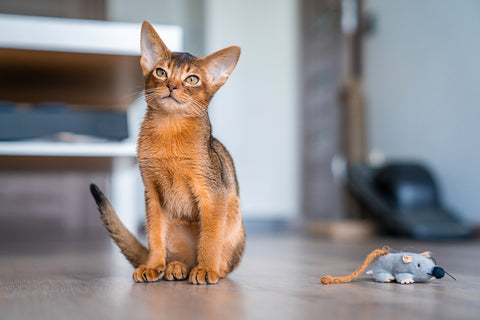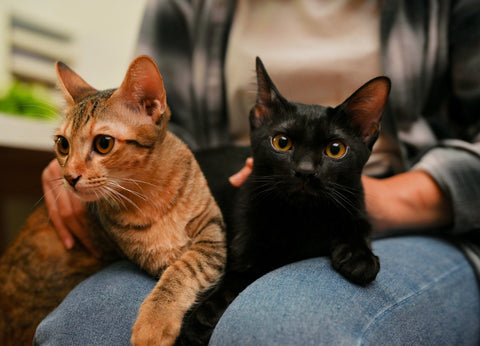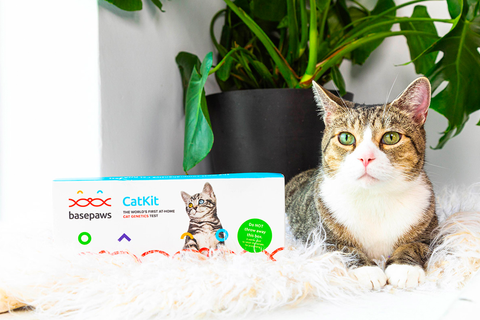
From time to time, we update the Basepaws digital report of results for our Breed + Health Cat DNA Test. Today, we’d like to take a moment to share some details about two recent changes to our report—one for a genetic health marker linked to the common cat heart condition hypertrophic cardiomyopathy, and one for a genetic trait marker associated with the Siamese colorpoint coat pattern.
Cat Heart Health
For the normal function of your kitty’s heart, their heart muscle must be able to relax and contract properly. An important protein that helps coordinate their heart muscle contraction is called cardiac troponin T. There’s a gene that provides the instructions needed to make cardiac troponin T—in both cats and in humans—and it’s called TNNT2.
Genes can have variants, which are permanent changes in their DNA sequence.
- In 2020, scientists thought that they found the first ever connection between a TNNT2 gene variant and the most common feline heart condition: hypertrophic cardiomyopathy (HCM).
- However, this study made this conclusion based on the DNA analysis of only one Maine Coon cat and the fact that a TNNT2 variant had previously been linked to HCM in humans.

New research findings can either reinforce an existing body of knowledge on a genetic marker’s link to a disease, or uncover new evidence suggesting that the suspected link may not exist or not be as clear-cut as originally thought.
- In August 2022, new HCM-related research on the previously identified TNNT2 variant provided new evidence demonstrating that this TNNT2 variant has no association with HCM risk in cats.
- This study had greater statistical power, as it analyzed DNA samples from a much larger group of 160 Maine Coon cats from many different geographic locations.
- This means that its conclusions can be interpreted with greater confidence than the 2020 study that analyzed the DNA of only one cat.
The field of genetics (like many other scientific fields) is always evolving. Basepaws reviews new research on the genetic health and trait markers for which we screen in our Cat DNA Test and evaluates it against the known body of knowledge. We then score the strength of the available research on each marker’s connection to disease within our five-star scientific evidence grading system.
Basepaws works on the cutting edge of science, but reporting on “hot off the press” findings before they have been confirmed by additional studies comes with an inherent risk.
- This is another reason why we created our evidence grading system, so that we can share whether findings are only preliminary, as was the case with the earlier 2020 study, or if they are well-supported by multiple studies.
- The 2022 study is a case of the latter—its more robust findings reveal that the evidence linking the TNNT2 variant to HCM risk in cats does not hold up to scientific scrutiny.
As a result, Basepaws is no longer providing results for this TNNT2 variant in our Cat DNA Test digital report.
This also means that if you are a pet parent whose cat was previously identified as having 2 copies of the TNNT2 mutation in their report, you can breathe easier with this new evidence on TNNT2 and feline HCM risk. As always, Basepaws recommends sharing your report with your veterinarian and collaborating with them on a proactive approach to your cat’s health that meets their unique needs. Sharing your report is a simple click away from within your Basepaws customer account!
Cat Coat Patterns
The Siamese colorpoint coat pattern trait occurs most frequently in Siamese, Birman, and Himalayan cats.
- This trait is due to a temperature-sensitive variant in the tyrosinase (TYR) gene, which affects pigment production and causes a form of partial albinism (absence of melanin)
- In warmer areas of the body, pigment production is reduced. In the cooler extremities, such as the ears, tails, and paws of a cat, darker pigmentation occurs.
The Basepaws report provides results on three different variants in the TYR gene that are associated with the Siamese colorpoint coat pattern.
- It came to our attention that a few customers’ cats had a positive “likely to have” result for Siamese coat color.
- In these cases, their cats neither had genomic similarity to Siamese, Birman, or Himalayan cat breeds in their cats’ breed profiles, nor did they express the Siamese coat color trait.

There is still a lot to learn about cat coat genetics, so it is possible for a cat to have such a result, yet not display the colorpoint trait, because another genetic variant could be “masking” the phenotype (aka expression) of the trait. However, in similar fashion to our frequent review of new scientific evidence, we chose to investigate the new evidence that was being reported by our customers.
One loyal Basepaws customer in particular, Charles Warden, helped us with our investigation since his cat, named Bastu, was one of these cases. We found out what was going on and promptly made an adjustment in our reporting process. We checked this adjustment in new reports with Charles and other customers, and no more false “likely to have” results are occurring for the Siamese coat colorpoint pattern. Thank you Charles and Bastu!
Your Next Basepaws Report
If your cat previously had results for the TNNT2 gene variant, you will no longer see these in your next report version. The removal of TNNT2 from our reporting also changes the total number of genetic markers for which we screen. We now present your cat’s results for 64 (previously 65) markers associated with genetic health conditions like HCM. Since we still screen for 50 markers linked to traits such as the Siamese colorpoint coat pattern, this brings the new total of genetic markers included in our Breed + Health Cat DNA Test to 114 (previously 115).
For the Siamese colorpoint coat, the adjustment that we made simply means that there will be no more false “likely to have” results for this trait. New report versions will reflect this change for any Basepaws customers (and their kitties!) to whom this applies.
In conclusion, we’d like to leave you with a picture of Charles’s cat Bastu! Isn’t she lovely?




